Home automation
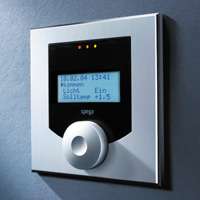
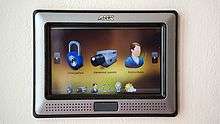
Home automation or smart home[1] (also known as domotics or domotica) is the residential extension of building automation and involves the control and automation of lighting, heating (such as smart thermostats), ventilation, air conditioning (HVAC), and security, as well as home appliances such as washer/dryers, ovens or refrigerators/freezers that use WiFi for remote monitoring. Modern systems generally consist of switches and sensors connected to a central hub sometimes called a "gateway" from which the system is controlled with a user interface that is interacted either with a wall-mounted terminal, mobile phone software, tablet computer or a web interface, often but not always via internet cloud services.
While there are many competing vendors, there are very few world-wide accepted industry standards and the smart home space is heavily fragmented.[2] Popular communications protocol for products include X10, Ethernet, RS-485, 6LoWPAN, Bluetooth LE (BLE), ZigBee and Z-Wave, or other proprietary protocols all of which are incompatible with each other.[3] Manufacturers often prevent independent implementations by withholding documentation and by suing people.[4]
The home automation market was worth US$5.77 billion in 2015, predicted to have a market value over US$10 billion by the year 2020.[5]
History
The word "domotics" (and "domotica" when used as a verb) is a contraction of the Latin word for a home "domus" and the words/fields informatics, telematics and robotics.
Early home automation began with labor-saving machines. Self-contained electric or gas powered home appliances became viable in the 1900s with the introduction of electric power distribution[6] and led to the introduction of washing machines (1904), water heaters (1889), refrigerators, sewing machines, dishwashers, and clothes dryers.
In 1975, the first general purpose home automation network technology, X10, was developed. It is a communication protocol for electronic devices. It primarily uses electric power transmission wiring for signalling and control, where the signals involve brief radio frequency bursts of digital data, and remains the most widely available.[7] By 1978, X10 products included a 16 channel command console, a lamp module, and an appliance module. Soon after came the wall switch module and the first X10 timer.
By 2012, in the United States, according to ABI Research, 1.5 million home automation systems were installed.[8]
According to Li et. al. (2016) there are three generations of home automation:[9]
- First generation: wireless technology with proxy server, e.g. Zigbee automation;
- Second generation: artificial intelligence controls electrical devices, e.g. amazon echo;
- Third generation: robot buddy "who" interacts with humans, e.g. Robot Rovio, Roomba.
Applications and technologies
- Heating, ventilation and air conditioning (HVAC): it is possible to have remote control of all home energy monitors over the internet incorporating a simple and friendly user interface.[10]
- Lighting control system
- Appliance control and integration with the smart grid and a smart meter, taking advantage, for instance, of high solar panel output in the middle of the day to run washing machines.[11][12]
- Security: a household security system integrated with a home automation system can provide additional services such as remote surveillance of security cameras over the Internet, or central locking of all perimeter doors and windows.[13]
- Leak detection, smoke and CO detectors[14][15]
- Indoor positioning systems
- Home automation for the elderly and disabled
Implementations
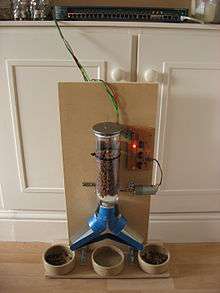
In a review of home automation devices, Consumer Reports found two main concerns for consumers:[16]
- A WiFi network connected to the internet can be vulnerable to hacking.
- Technology is still in its infancy, and consumers could invest in a system that becomes abandonware. In 2014, Google bought the company selling the Revolv Hub home automation system, integrated it with Nest and in 2016 shut down the servers Revolv Hub depended on, rendering the hardware useless.[17]
Microsoft Research found in 2011, that home automation could involve high cost of ownership, inflexibility of interconnected devices, and poor manageability.[18]
Historically systems have been sold as complete systems where the consumer relies on one vendor for the entire system including the hardware, the communications protocol, the central hub, and the user interface. However, there are now open source software systems which can be used with proprietary hardware.[18]
Protocols
There are a wide variety of technology platforms, or protocols, on which a smart home can be built. Each one is, essentially, its own language. Each language speaks to the various connected devices and instructs them to perform a function.
The automation protocol transport has involved direct wire connectivity, powerline (UPB) and wireless hybrid and wireless.
Most of the protocols below are not open. All have an API.
| Protocol | Media | Data Rate | Notes |
|---|---|---|---|
| C-Bus | Dedicated cable, RF (radio frequency) | 3500 bit/s | C-Bus is a communications protocol based on a seven layer OSI model for home and building automation that can handle cable lengths up to 1000 meter using Cat.5 cable. |
| EnOcean | RF | 9 600 bit/s | 902 MHz in North America |
| Insteon[19] | PLC, RF | Instantaneous: 13 165 bit/s, sustained: 2 880 bit/s | A family of X10-compatible lighting and home control products from SmartLabs Inc. that use both 915 MHz RF and powerline to transmit signals. All Insteon devices are repeaters of Insteon signals, which means the more devices installed in the home, the better the wireless network performs. Insteon devices accept and receive signals from X10 devices, but do not repeat them. |
| KNX | PLC, RF, twisted pair, infrared, Ethernet | 9 600 bit/s | Standardized by internationally (ISO/IEC), Canada (CSA-ISO), Europe (CENELEC/CEN), China (GB/T) |
| Thread | RF | 20 000 – 250 000 bit/s | Based on 6LowPAN with a networking protocol that is IPv6 addressable and it's aimed at the home automation environment. |
| Universal Powerline Bus | PLC | 480 bit/s | Universal Powerline Bus: is a 2-way communications technology which enables control products to utilize existing powerlines for both residential and commercial applications. |
| X10 | PLC, RF | 20 bit/s | A remote control system for lamps and appliances from X10 Wireless Technology that uses the home's electrical system as the signaling network. The standard powerline system since it was developed in 1975 for many years, x10 transmitters and receivers are set to one of 256 low-voltage codes. The controller, which contains the switch and transmitter, is an external unit that plugs into any AC outlet, or it replaces the light switch on the wall. The receiver plugs into the AC outlet, and the lamp or appliance plugs into the receiver. When the switch is activated, it sends a signal into the electrical line that is picked up by the receiver, which turns on/off or dims the lights. Several lamps can be treated as one group by setting their receivers to the same code. RF is 310 MHz in North America and 433 MHz in Europe. |
| xPL | Ethernet | >10 000 000 bit/s | Transmits commands and status within a LAN. Some systems, such as the Squeezebox audio player are directly controlled through an Ethernet connection. Others require a computer to bridge the xPL messages to the equipment's hardware interface such as RS-232. |
| Zigbee | RF | 20 000 – 250 000 bit/s | ZigBee PRO and ZigBee Remote Control (RF4CE), among other available ZigBee profiles, are based on the IEEE 802.15.4 protocol, which is an industry-standard wireless networking technology operating at 2.4 GHz targeting applications that require relatively infrequent data exchanges at low data-rates over a restricted area and within a 100 m range such as in a home or building. Additional radio frequencies used are 915 MHz (Americas and Australia) and 868 MHz (Europe). |
| Z-Wave | RF | 100 000 bit/s | Z-Wave is a low-power RF communications technology that is primarily designed for home automation products. Frequencies used are 908.42 MHz North America, other countries use sub-1 GHz[20] |
| SCS | twisted pair | 9600 bit/s | Proprietary by bTicino. Upper protocol is OpenWebNet |
Acronym explanation:
- PLC: Power line communication, communication using existing mains wiring
- RF: RF, transmission using a high frequency carrier
- Twisted pair: High speed signals using cables with twisted pairs to protect the signals
- Infrared: Optical communication using infrared light
- Ethernet: Well established standard for high capacity communications
Criticism and controversies
Home automation suffers from platform fragmentation and lack of technical standards[21][22][23][24][25][26] a situation where the variety of home automation devices, in terms of both hardware variations and differences in the software running on them, makes the task of developing applications that work consistently between different inconsistent technology ecosystems hard.[27] Customers may be hesitant to bet their IoT future on a proprietary software or hardware devices that uses proprietary protocols that may fade or become difficult to customize and interconnect.[28]
Home automation devices amorphous computing nature is also a problem for security, since patches to bugs found in the core operating system often do not reach users of older and lower-price devices.[29][30] One set of researchers say that the failure of vendors to support older devices with patches and updates leaves more than 87% of active devices vulnerable.[31][32]
Gallery
-

SkyControl home automation hub
-
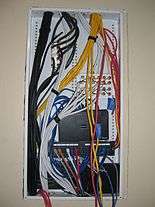
Domestic patch panel, unstructured.
-

Laptop controller for automated sprinkler system
-

Well and booster pump automation
-
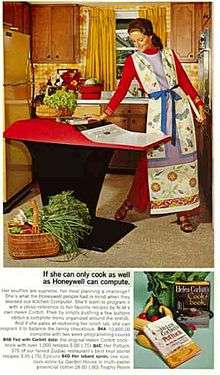
An ad for the Kitchen Computer in 1969.
See also
- Home automation for the elderly and disabled
- Internet of Things
- List of home automation software and hardware
- List of home automation topics
- List of network buses
- Smart device
- Web of Things
References
- ↑ "What is smart home - Basic Idea". cctvinstitute.co.uk. Retrieved 2016-10-29.
- ↑ "5 Open Source Home Automation Projects We Love". Fast Company. 2014-12-01. Retrieved 2016-11-22.
- ↑ "Best Home Automation System - Consumer Reports". www.consumerreports.org. Retrieved 2016-02-14.
- ↑ "Wireless Sensor Networks: Concepts, Applications, Experimentation and Analysis". 2016. p. 108. ISBN 9811004129.
The use of standardized, with open standards over proprietary protocols provides the industry with the freedom to choose between suppliers with guaranteed interoperability. Standardized solutions usually have a much longer lifespan than proprietary solutions.
- ↑ "Research and Markets: Global Home Automation and Control Market 2014-2020 - Lighting Control, Security & Access Control, HVAC Control Analysis of the $5.77 Billion Industry". Reuters. 2015-01-19. Archived from the original on 2016-05-05.
- ↑ Home Automation & Wiring (1 ed.). New York: McGraw-Hill/TAB Electronics. 1999-03-31. ISBN 9780070246744.
- ↑ Rye, Dave (October 1999). "My Life at X10". AV and Automation Industry eMagazine. AV and Automation Industry eMagazine. Retrieved October 8, 2014.
- ↑ "1.5 Million Home Automation Systems Installed in the US This Year". www.abiresearch.com. Retrieved 2016-11-22.
- ↑ Li, Rita Yi Man; Li, Herru Ching Yu; Mak, Cho Kei; Tang, Tony Beiqi. "Sustainable Smart Home and Home Automation: Big Data Analytics Approach" (PDF). International Journal of Smart Home. 10 (8): 177–198. doi:10.14257/ijsh.2016.10.8.18.
- ↑ Preville, Cherie (26 Aug 2013). "Control Your Castle: The Latest in HVAC Home Automation". ACHRNews. ACHRNews. Retrieved 15 Jun 2015.
- ↑ Berger, Lars T.; Schwager, Andreas; Pagani, Pascal; Schneider, Daniel M. (February 2014). Smart Grid Applications, Communications, and Security. Devices, Circuits, and Systems. CRC Press. ISBN 9781466557529.
- ↑ "Tips: Smart Appliances | Department of Energy". energy.gov. Retrieved 2016-04-20.
- ↑ Griffiths, Melanie (March 2008). "Smart Home Security". Homebuilding & Renovating. Retrieved 27 February 2012.
- ↑ "Nest Protect | Smoke and CO Alarms - Consumer Reports News". www.consumerreports.org. Retrieved 2016-04-20.
- ↑ "Nest Protect | Smoke and CO Alarms - Consumer Reports News". Retrieved 2016-11-22.
- ↑ "Best Home Automation System - Consumer Reports". Retrieved 2016-11-22.
- ↑ "Google's parent company is deliberately disabling some of its customers' old smart-home devices". Business Insider. Retrieved 2016-11-22.
- 1 2 Brush, A. J.; Lee, Bongshin; Mahajan, Ratul; Agarwal, Sharad; Saroiu, Stefan; Dixon, Colin (2011-05-01). "Home Automation in the Wild: Challenges and Opportunities". Microsoft Research.
- ↑ Insteon whitepaper: The Details (PDF).
- ↑ Z-Wave Frequency Coverage (PDF).
- ↑ "IoT experts fret over fragmentation - Mobile World Live". Mobile World Live. 2016-02-25. Retrieved 2016-11-22.
- ↑ "Fragmentation is the enemy of the Internet of Things | Qualcomm". Qualcomm. 2016-02-19. Retrieved 2016-11-22.
- ↑ "Internet of Things: Opportunities and challenges for semiconductor companies". McKinsey & Company. Retrieved 2016-11-22.
- ↑ http://www.arm.com/zh/files/event/ATF2015SZ_A6_Thundersoft.pdf IOT Brings Fragmentation in Platform
- ↑ https://www.w3.org/Talks/2016/04-27-countering-fragmentation.pdf Countering Fragmentation with the Web of Things
- ↑ Steve Kovach (July 30, 2013). "Android Fragmentation Report". Business Insider. Retrieved October 19, 2013.
- ↑ "Who Needs the Internet of Things?". Linux.com | The source for Linux information. Retrieved 2016-11-22.
- ↑ "21 Open Source Projects for IoT". Linux.com | The source for Linux information. Retrieved 2016-11-22.
- ↑ Franceschi-Bicchierai, Lorenzo. "Goodbye, Android". Motherboard. Vice. Retrieved August 2, 2015.
- ↑ Kingsley-Hughes, Adrian. "The toxic hellstew survival guide". ZDnet. Retrieved August 2, 2015.
- ↑ Tung, Liam (2015-10-13). "Android security a 'market for lemons' that leaves 87 percent vulnerable". zdnet.com. ZDNet. Retrieved 2015-10-14.
- ↑ Thomas, Daniel R.; Beresford, Alastair R.; Rice, Andrew. "Security Metrics for the Android Ecosystem" (PDF). Computer Laboratory, University of Cambridge. doi:10.1145/2808117.2808118. Retrieved 2015-10-14.
